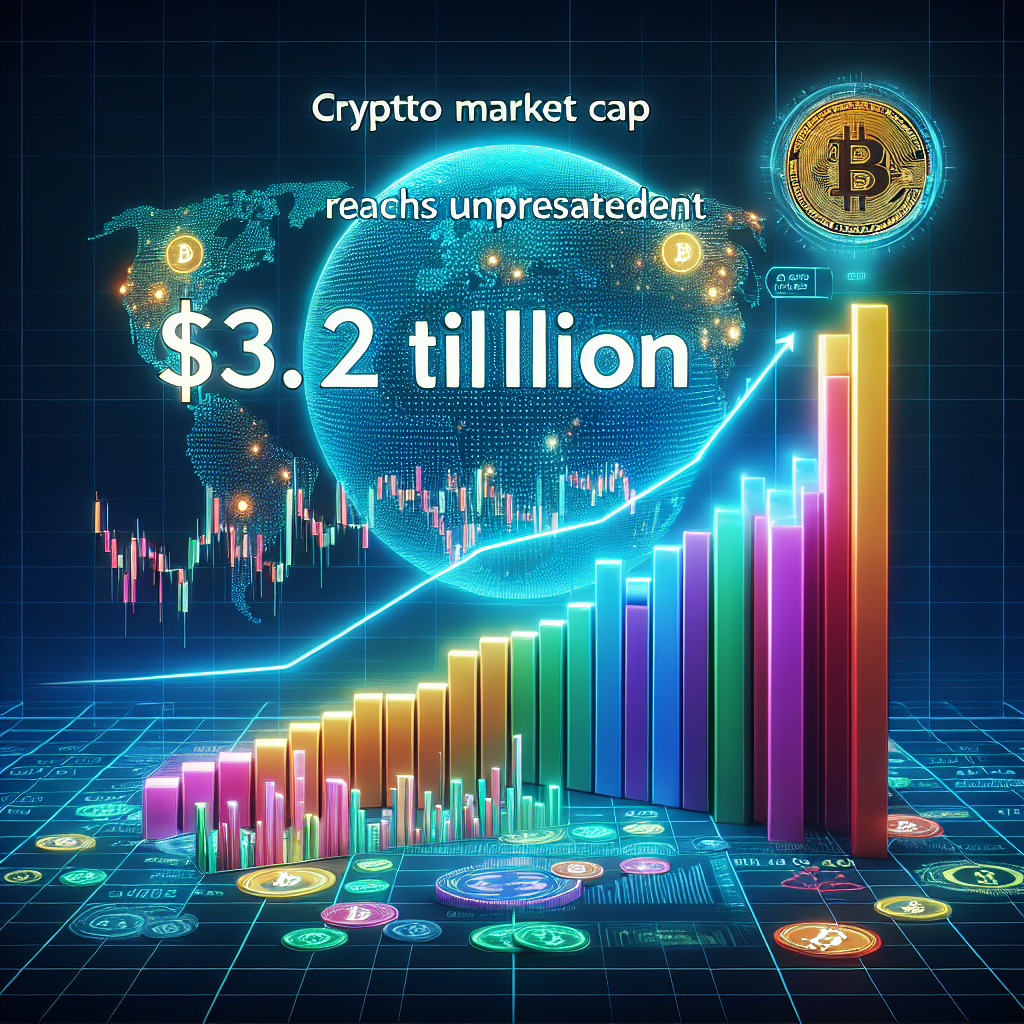“Crypto Soars: Market Cap Hits Historic $3.2 Trillion Milestone!”
Introduction
In a landmark development for the digital finance world, the cryptocurrency market has reached an unprecedented valuation of $3.2 trillion, according to recent reports from CoinGecko. This milestone underscores the rapid growth and increasing mainstream acceptance of cryptocurrencies as a significant asset class. The surge in market capitalization reflects heightened investor interest, technological advancements, and broader adoption of digital currencies across various sectors. As the crypto market continues to evolve, this remarkable achievement highlights both the potential and the volatility inherent in this dynamic financial landscape.
Understanding The Factors Behind The Crypto Market’s $3.2 Trillion Milestone
The cryptocurrency market has recently achieved a remarkable milestone, with its total market capitalization reaching an unprecedented $3.2 trillion, as reported by CoinGecko. This significant achievement underscores the growing influence and acceptance of digital currencies in the global financial landscape. To understand the factors contributing to this milestone, it is essential to examine the various elements that have driven the market to this point.
Firstly, the increasing institutional adoption of cryptocurrencies has played a pivotal role in propelling the market to new heights. Over the past few years, major financial institutions, including banks, hedge funds, and asset management firms, have begun to recognize the potential of digital assets as a viable investment class. This shift in perception has been fueled by the growing demand from clients seeking exposure to cryptocurrencies as a means of diversification and hedging against traditional market volatility. Consequently, the influx of institutional capital has provided a substantial boost to the overall market capitalization.
In addition to institutional interest, the rise of decentralized finance (DeFi) has significantly contributed to the expansion of the crypto market. DeFi platforms, which offer financial services such as lending, borrowing, and trading without the need for intermediaries, have gained immense popularity among investors seeking innovative ways to maximize returns. The rapid growth of DeFi has not only attracted substantial capital inflows but has also spurred the development of new financial products and services, further enhancing the appeal of the cryptocurrency market.
Moreover, the increasing mainstream acceptance of cryptocurrencies as a legitimate form of payment has also played a crucial role in driving market growth. Major companies, including Tesla, PayPal, and Square, have integrated digital currencies into their payment systems, allowing consumers to transact using cryptocurrencies. This widespread adoption has helped to legitimize digital assets in the eyes of the public and has encouraged more individuals to participate in the market, thereby contributing to its overall expansion.
Furthermore, the ongoing advancements in blockchain technology have facilitated the development of more efficient and secure platforms for conducting transactions. These technological improvements have not only enhanced the functionality of existing cryptocurrencies but have also paved the way for the creation of new digital assets with unique use cases. As a result, the diversity and utility of cryptocurrencies have expanded, attracting a broader range of investors and users to the market.
Additionally, the global economic environment has also played a role in the crypto market’s growth. In the face of economic uncertainty and inflationary pressures, many investors have turned to cryptocurrencies as a store of value and a hedge against currency devaluation. This trend has been particularly pronounced in regions experiencing economic instability, where digital assets offer an alternative to traditional financial systems.
In conclusion, the crypto market’s achievement of a $3.2 trillion market capitalization is the result of a confluence of factors, including increased institutional adoption, the rise of decentralized finance, mainstream acceptance, technological advancements, and global economic conditions. As these elements continue to evolve, the cryptocurrency market is likely to experience further growth and transformation, solidifying its position as a significant player in the global financial ecosystem.
The Role Of Institutional Investment In The Crypto Market’s Growth
The recent report by CoinGecko, indicating that the cryptocurrency market cap has reached an unprecedented $3.2 trillion, underscores the significant role of institutional investment in driving this remarkable growth. Over the past few years, the cryptocurrency market has evolved from a niche interest to a mainstream financial asset class, largely due to the increasing involvement of institutional investors. This shift has not only provided the market with much-needed liquidity but has also contributed to its legitimacy and stability.
Institutional investors, such as hedge funds, asset managers, and even pension funds, have gradually recognized the potential of cryptocurrencies as a viable investment vehicle. Their entry into the market has been facilitated by the development of more sophisticated financial products and services tailored to meet their needs. For instance, the introduction of Bitcoin futures and exchange-traded funds (ETFs) has provided these investors with regulated and secure avenues to gain exposure to digital assets. Consequently, this has led to a surge in demand, driving up the market capitalization to its current levels.
Moreover, the involvement of institutional investors has brought about a more mature market environment. Their participation has necessitated the implementation of robust regulatory frameworks and compliance measures, which have, in turn, enhanced the overall credibility of the cryptocurrency market. This regulatory oversight has been crucial in mitigating risks associated with market manipulation and fraud, thereby fostering a more transparent and trustworthy ecosystem. As a result, more traditional financial institutions have been encouraged to explore opportunities within the crypto space, further fueling its growth.
In addition to regulatory advancements, the technological infrastructure supporting the cryptocurrency market has also seen significant improvements. Institutional investors have played a pivotal role in driving innovation in this area, as their requirements for security, scalability, and efficiency have pushed service providers to develop cutting-edge solutions. Enhanced custody services, for example, have addressed concerns regarding the safe storage of digital assets, while advancements in blockchain technology have improved transaction speeds and reduced costs. These developments have made it increasingly feasible for large-scale investors to participate in the market, thereby contributing to its expansion.
Furthermore, the macroeconomic environment has also played a part in attracting institutional investment to the cryptocurrency market. In recent years, factors such as low interest rates, inflationary pressures, and geopolitical uncertainties have prompted investors to seek alternative assets that can offer diversification and potential hedging benefits. Cryptocurrencies, with their decentralized nature and limited supply, have emerged as an attractive option in this context. Institutional investors, recognizing these attributes, have allocated a portion of their portfolios to digital assets, thereby driving up demand and market capitalization.
It is also worth noting that the growing acceptance of cryptocurrencies as a legitimate asset class has been bolstered by the increasing number of high-profile endorsements from influential figures and corporations. These endorsements have not only raised awareness but have also instilled confidence among institutional investors, encouraging them to explore the potential of digital assets further. As more institutions enter the market, their collective influence is likely to continue shaping its trajectory, potentially leading to even greater levels of adoption and integration within the global financial system.
In conclusion, the unprecedented growth of the cryptocurrency market, as reported by CoinGecko, can be largely attributed to the significant role played by institutional investors. Their involvement has brought about increased liquidity, enhanced credibility, and technological advancements, all of which have contributed to the market’s expansion. As the landscape continues to evolve, the influence of institutional investment is expected to remain a key driver of growth, paving the way for the continued maturation and integration of cryptocurrencies into the broader financial ecosystem.
How Altcoins Contributed To The Crypto Market’s Record-Breaking Valuation
The cryptocurrency market has reached an unprecedented milestone, with its total market capitalization soaring to $3.2 trillion, as reported by CoinGecko. This remarkable achievement underscores the growing influence and acceptance of digital currencies in the global financial landscape. While Bitcoin and Ethereum have traditionally dominated the market, the recent surge can be largely attributed to the significant contributions of altcoins. These alternative cryptocurrencies have played a pivotal role in driving the market to new heights, reflecting a diversification trend that is reshaping the crypto ecosystem.
Altcoins, which encompass a wide range of digital assets beyond Bitcoin, have gained substantial traction among investors and enthusiasts alike. This surge in interest can be attributed to several factors, including technological innovation, unique use cases, and community-driven projects. For instance, altcoins such as Solana, Cardano, and Polkadot have introduced advanced blockchain technologies that promise faster transaction speeds and enhanced scalability. These technological advancements have not only attracted developers and projects but have also captured the attention of institutional investors seeking to diversify their portfolios.
Moreover, the rise of decentralized finance (DeFi) platforms has further fueled the growth of altcoins. DeFi, which aims to recreate traditional financial systems using blockchain technology, has seen explosive growth over the past year. Altcoins like Uniswap, Aave, and Chainlink have become integral components of the DeFi ecosystem, offering decentralized exchanges, lending platforms, and oracle services. The increasing adoption of DeFi protocols has driven demand for these altcoins, contributing significantly to the overall market capitalization.
In addition to DeFi, the burgeoning non-fungible token (NFT) market has also played a crucial role in the altcoin surge. NFTs, which represent unique digital assets, have gained immense popularity in the art, gaming, and entertainment industries. Altcoins such as Ethereum, Flow, and Tezos have been at the forefront of the NFT revolution, providing the underlying infrastructure for NFT marketplaces and platforms. The growing interest in NFTs has not only boosted the value of these altcoins but has also highlighted the diverse applications of blockchain technology beyond traditional finance.
Furthermore, the increasing regulatory clarity in various jurisdictions has provided a conducive environment for the growth of altcoins. As governments and regulatory bodies around the world begin to establish frameworks for digital assets, investor confidence has been bolstered. This regulatory progress has encouraged more individuals and institutions to explore altcoins as viable investment opportunities, thereby driving up their market value.
It is also important to note the role of community engagement and social media in the rise of altcoins. Platforms like Reddit, Twitter, and Discord have become hubs for crypto enthusiasts to share information, discuss projects, and rally support for their favorite altcoins. This grassroots movement has led to the rapid dissemination of information and has often resulted in significant price movements for certain altcoins, further contributing to the overall market capitalization.
In conclusion, the unprecedented $3.2 trillion valuation of the cryptocurrency market is a testament to the transformative impact of altcoins. Through technological innovation, the rise of DeFi and NFTs, regulatory advancements, and community engagement, altcoins have emerged as key drivers of growth in the crypto space. As the market continues to evolve, it is clear that altcoins will play an increasingly important role in shaping the future of digital finance.
The Impact Of Regulatory Developments On The Crypto Market Cap

The cryptocurrency market has recently reached an unprecedented milestone, with its total market capitalization soaring to $3.2 trillion, as reported by CoinGecko. This remarkable achievement underscores the growing influence and acceptance of digital currencies in the global financial landscape. However, this surge in market cap is not merely a result of increased investor interest or technological advancements; it is also significantly influenced by regulatory developments across various jurisdictions. Understanding the impact of these regulatory changes is crucial for comprehending the dynamics of the crypto market.
To begin with, regulatory clarity has played a pivotal role in fostering confidence among investors and institutions. In recent years, several countries have taken steps to establish clear guidelines and frameworks for the operation of cryptocurrencies. For instance, the United States has seen increased efforts by the Securities and Exchange Commission (SEC) to define the status of digital assets, providing a clearer path for compliance. Similarly, the European Union has been working on the Markets in Crypto-Assets (MiCA) regulation, which aims to create a harmonized regulatory environment across member states. These efforts have contributed to a more predictable and stable market, encouraging both retail and institutional investors to participate more actively.
Moreover, the introduction of regulatory measures has also helped in mitigating risks associated with cryptocurrencies, such as fraud and money laundering. By implementing stringent Know Your Customer (KYC) and Anti-Money Laundering (AML) requirements, regulators have been able to enhance the security and integrity of the crypto market. This, in turn, has attracted a broader range of participants, including traditional financial institutions that were previously hesitant to engage with digital assets due to concerns over regulatory compliance and reputational risks.
In addition to fostering investor confidence, regulatory developments have also spurred innovation within the crypto industry. As governments and regulatory bodies establish clearer rules, crypto companies are better positioned to develop new products and services that comply with these regulations. This has led to the emergence of innovative financial instruments, such as crypto derivatives and exchange-traded funds (ETFs), which have further expanded the market’s reach and appeal. Consequently, the increased availability of diverse investment options has contributed to the overall growth of the market cap.
However, it is important to note that regulatory developments can also pose challenges to the crypto market. In some cases, overly stringent regulations may stifle innovation and limit market growth. For example, certain countries have imposed outright bans on cryptocurrency trading or mining, citing concerns over financial stability and environmental impact. Such measures can lead to market fragmentation and hinder the global adoption of digital currencies. Therefore, striking a balance between regulation and innovation remains a critical challenge for policymakers worldwide.
In conclusion, the unprecedented rise in the crypto market cap to $3.2 trillion is a testament to the sector’s resilience and adaptability in the face of evolving regulatory landscapes. While regulatory developments have played a crucial role in shaping the market, they have also introduced new complexities that require careful navigation. As the crypto industry continues to mature, ongoing dialogue between regulators, industry participants, and other stakeholders will be essential to ensure that the market remains robust, secure, and conducive to innovation. Ultimately, the future trajectory of the crypto market will depend on how effectively these regulatory challenges are addressed, paving the way for sustainable growth and integration into the broader financial ecosystem.
Analyzing The Influence Of DeFi And NFTs On The Crypto Market Surge
The cryptocurrency market has recently achieved a remarkable milestone, with its total market capitalization reaching an unprecedented $3.2 trillion, as reported by CoinGecko. This significant surge can be attributed to the burgeoning sectors of Decentralized Finance (DeFi) and Non-Fungible Tokens (NFTs), which have played pivotal roles in driving the market’s expansion. As these innovative technologies continue to evolve, they are reshaping the financial landscape and attracting a diverse range of investors, thereby contributing to the overall growth of the crypto market.
To begin with, the rise of DeFi has been instrumental in the recent market surge. DeFi platforms offer decentralized financial services, such as lending, borrowing, and trading, without the need for traditional intermediaries like banks. This democratization of financial services has opened up new opportunities for individuals who were previously excluded from the traditional financial system. Moreover, DeFi’s ability to provide higher yields compared to conventional savings accounts has attracted a significant influx of capital from both retail and institutional investors. As a result, the total value locked in DeFi protocols has skyrocketed, further propelling the crypto market’s growth.
In addition to DeFi, the explosion of interest in NFTs has also contributed to the market’s expansion. NFTs, which are unique digital assets representing ownership of a specific item or piece of content, have gained immense popularity in recent years. This surge in interest can be attributed to the growing recognition of digital art, collectibles, and virtual real estate as valuable assets. The NFT market has attracted a wide array of participants, including artists, musicians, and celebrities, who are leveraging this technology to monetize their creations and engage with their audiences in novel ways. Consequently, the NFT sector has seen a substantial increase in trading volumes, further boosting the overall market capitalization of cryptocurrencies.
Furthermore, the integration of DeFi and NFTs into mainstream financial systems has been facilitated by advancements in blockchain technology. The development of more scalable and efficient blockchain networks has enabled these sectors to flourish, providing the necessary infrastructure for their continued growth. Additionally, the increasing adoption of cryptocurrencies by major corporations and financial institutions has lent credibility to the market, encouraging more investors to participate. This institutional interest has not only provided a sense of legitimacy but has also contributed to the market’s liquidity and stability.
However, it is important to acknowledge the challenges and risks associated with the rapid growth of DeFi and NFTs. The decentralized nature of these technologies presents regulatory challenges, as governments and financial authorities grapple with how to effectively oversee and manage this burgeoning sector. Moreover, the volatility inherent in the crypto market poses risks to investors, particularly those who may not fully understand the complexities of these new financial instruments. As such, it is crucial for stakeholders to engage in ongoing dialogue and collaboration to address these issues and ensure the sustainable development of the crypto market.
In conclusion, the unprecedented growth of the cryptocurrency market, reaching a market cap of $3.2 trillion, can be largely attributed to the influence of DeFi and NFTs. These sectors have not only expanded the possibilities within the financial landscape but have also attracted a diverse range of participants, driving the market’s expansion. As the crypto market continues to evolve, it will be essential for stakeholders to navigate the associated challenges and risks to ensure its continued growth and stability.
The Future Of Cryptocurrency: What A $3.2 Trillion Market Cap Means
The cryptocurrency market has reached a significant milestone, with its market capitalization soaring to an unprecedented $3.2 trillion, as reported by CoinGecko. This remarkable achievement underscores the growing influence and acceptance of digital currencies in the global financial landscape. As the market continues to expand, it is essential to explore what this milestone means for the future of cryptocurrency and its potential implications for investors, regulators, and the broader economy.
To begin with, the surge in market capitalization reflects a heightened interest from both institutional and retail investors. Over the past few years, cryptocurrencies have transitioned from niche digital assets to mainstream investment vehicles. This shift is largely driven by the increasing recognition of cryptocurrencies as a legitimate asset class, offering diversification benefits and potential hedges against inflation. Furthermore, the entry of institutional players, such as hedge funds and asset management firms, has injected substantial capital into the market, contributing to its rapid growth.
In addition to increased investment, technological advancements have played a crucial role in propelling the cryptocurrency market to new heights. The development of blockchain technology has facilitated the creation of innovative financial products and services, such as decentralized finance (DeFi) platforms and non-fungible tokens (NFTs). These innovations have not only expanded the utility of cryptocurrencies but have also attracted a broader audience, eager to explore the possibilities offered by this new digital frontier.
Moreover, the growing market cap signifies a shift in public perception and acceptance of cryptocurrencies. As digital currencies become more integrated into everyday transactions, they are increasingly viewed as viable alternatives to traditional fiat currencies. This shift is evidenced by the adoption of cryptocurrencies by major corporations and payment processors, which have begun to accept digital currencies as a form of payment. Consequently, this growing acceptance is likely to drive further adoption and integration of cryptocurrencies into the global financial system.
However, the rapid growth of the cryptocurrency market also presents challenges and risks that must be addressed. Regulatory scrutiny is intensifying as governments and financial authorities grapple with the implications of a decentralized financial system. The lack of a unified regulatory framework poses a significant challenge, as inconsistent regulations across jurisdictions can create uncertainty and hinder the market’s development. Therefore, it is crucial for regulators to strike a balance between fostering innovation and ensuring consumer protection and market stability.
Furthermore, the environmental impact of cryptocurrency mining has become a pressing concern. The energy-intensive nature of mining operations, particularly for proof-of-work cryptocurrencies like Bitcoin, has raised questions about the sustainability of the industry. As the market continues to grow, it is imperative for stakeholders to explore more sustainable practices and technologies to mitigate the environmental impact.
In conclusion, the cryptocurrency market’s achievement of a $3.2 trillion market cap marks a pivotal moment in its evolution. This milestone highlights the growing acceptance and integration of digital currencies into the global financial system, driven by increased investment, technological advancements, and shifting public perceptions. However, it also underscores the need for careful consideration of regulatory and environmental challenges. As the market continues to evolve, stakeholders must work collaboratively to ensure that the future of cryptocurrency is both innovative and sustainable, paving the way for a new era in the financial landscape.
Lessons From The Crypto Market’s Journey To A $3.2 Trillion Valuation
The cryptocurrency market has reached an unprecedented milestone, with its total market capitalization soaring to $3.2 trillion, as reported by CoinGecko. This remarkable achievement underscores the rapid evolution and growing acceptance of digital currencies in the global financial landscape. As we reflect on this journey, several key lessons emerge that can provide valuable insights for investors, regulators, and market participants alike.
To begin with, the meteoric rise of the crypto market highlights the power of technological innovation in reshaping traditional financial systems. Cryptocurrencies, underpinned by blockchain technology, have introduced a decentralized model that challenges conventional banking and financial services. This shift has been driven by a growing demand for more transparent, secure, and efficient ways to conduct transactions. As a result, digital currencies have gained traction not only among individual investors but also among institutional players seeking to diversify their portfolios and hedge against inflation.
Moreover, the journey to a $3.2 trillion valuation underscores the importance of adaptability and resilience in the face of market volatility. The crypto market has experienced significant fluctuations, with prices often subject to dramatic swings. However, despite these challenges, the market has demonstrated an ability to recover and grow, driven by continuous innovation and the introduction of new products and services. This resilience is a testament to the underlying strength and potential of the crypto ecosystem, which continues to attract new participants and investment.
In addition, the rise of the crypto market has highlighted the critical role of regulation in fostering a sustainable and secure environment for digital assets. As cryptocurrencies have gained prominence, regulators worldwide have grappled with the challenge of balancing innovation with consumer protection and financial stability. The development of clear regulatory frameworks has been instrumental in legitimizing the market and building trust among investors. These frameworks have also encouraged the entry of traditional financial institutions, further fueling the market’s growth.
Furthermore, the journey to this milestone has underscored the significance of education and awareness in driving adoption. As digital currencies become more mainstream, there is a growing need for individuals and businesses to understand the intricacies of the crypto market. Educational initiatives and resources have played a crucial role in demystifying cryptocurrencies and empowering users to make informed decisions. This increased awareness has contributed to a broader acceptance and integration of digital assets into everyday financial activities.
Additionally, the crypto market’s growth has been fueled by the rise of decentralized finance (DeFi) and non-fungible tokens (NFTs), which have opened new avenues for investment and innovation. DeFi platforms have revolutionized traditional financial services by offering decentralized lending, borrowing, and trading solutions, while NFTs have created new opportunities for artists and creators to monetize their work. These developments have expanded the scope and appeal of the crypto market, attracting a diverse range of participants and driving further growth.
In conclusion, the crypto market’s journey to a $3.2 trillion valuation offers valuable lessons on the transformative power of technology, the importance of resilience, the role of regulation, the need for education, and the potential of emerging trends. As the market continues to evolve, these insights will be crucial in navigating the opportunities and challenges that lie ahead. The future of the crypto market remains promising, with the potential to redefine the global financial landscape and create new possibilities for innovation and growth.
Q&A
1. **What milestone did the crypto market cap reach according to CoinGecko?**
The crypto market cap reached an unprecedented $3.2 trillion.
2. **When did the crypto market cap reach this milestone?**
The specific date is not provided, but it was reported during a period of significant market growth.
3. **Which cryptocurrencies contributed most to this market cap increase?**
Major cryptocurrencies like Bitcoin and Ethereum were significant contributors, along with emerging altcoins.
4. **What factors drove the increase in the crypto market cap?**
Factors included increased institutional investment, growing adoption of blockchain technology, and positive regulatory developments.
5. **How does this milestone compare to previous market cap records?**
This milestone surpasses previous records, indicating substantial growth in the crypto market.
6. **What impact did this have on investor sentiment?**
The milestone likely boosted investor confidence and attracted more interest in the crypto market.
7. **What are potential risks associated with such a high market cap?**
Potential risks include market volatility, regulatory changes, and the possibility of a market correction.
Conclusion
The cryptocurrency market has reached a historic milestone, with its total market capitalization hitting an unprecedented $3.2 trillion, as reported by CoinGecko. This significant achievement underscores the growing acceptance and integration of digital assets into the global financial system. The surge in market cap reflects increased investor interest, institutional adoption, and the expansion of blockchain technology applications. However, this rapid growth also highlights the need for regulatory clarity and risk management to ensure sustainable development in the crypto space. As the market continues to evolve, stakeholders must navigate the challenges and opportunities presented by this dynamic and transformative sector.





